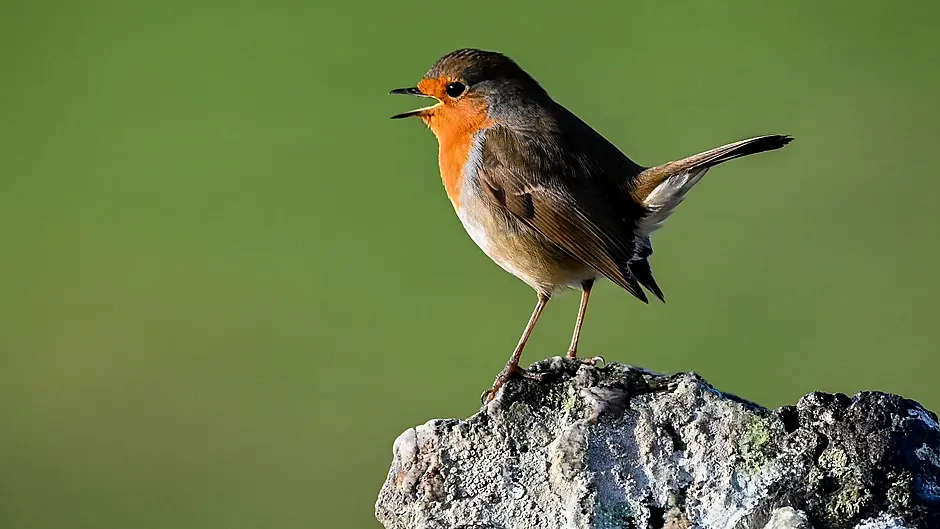
AS Christmas approaches, even the most dedicated wildlife enthusiasts, myself included, must admit that appreciating nature often drops down the list of priorities. The festive season often becomes a whirlwind of gift shopping, guest preparations, and last-minute organising, leaving little time for anything else.
So, keeping things simple on the wildlife front this week, let’s focus on what I consider the most festive native animal in our local area: the humble robin. A familiar sight in our gardens and countryside, the robin is also the star of countless Christmas cards, decorations, and even jumpers worldwide, making them an unmistakable symbol of the season both indoors and out. With that in mind, let’s take a moment to appreciate this charismatic and cheerful little bird.
Rocking robin
European robins (Erithacus rubecula) are lively birds that rarely go unnoticed. They are resident in Ireland and are considered our country’s most widespread garden bird, though they may also be found in a wide range of habitats, including woodland, hedges in farmland, and heathland. At this time of year, they can often be seen foraging busily to make the most of the shortened daylight hours, or heard singing loudly to mark and defend their territory from neighbouring robins. Robins are unusual in that they sing year-round, with both males and females being equally vocal. Additionally, unlike many bird species, males and females look alike, making it extremely difficult to tell them apart, with both sporting that typical deep red-orange breast.
Imposters
The European robin is a member of a group of birds known as the Old World fly-catchers, or chats. As the name suggests, they are found across Europe, as far east as Western Siberia and as far south as North Africa. It is worth noting, however, that they are just one of many birds referred to as ‘robins’ worldwide because the term is often applied to unrelated species which also display red or orange breasts. These include the American robin (Turdus migratorius), a thrush, and the Australasian robins of the family Petroicidae.
Famously, despite Mary Poppins being set in Britain, American robins, a non-native species, were erroneously featured in the famous scene A Spoonful of Sugar.
Keep your wildlife-spotting eye out for that blooper during the Christmas movie season!
 A juvenile robin just getting adult plumage. (Photo: Nick Haigh)
A juvenile robin just getting adult plumage. (Photo: Nick Haigh)Robin redbreast
You may be curious as to why robins are associated with Christmas. The main theory is that it is due to the postmen in England in Victorian times, who wore Royal Mail red uniforms, and became known as robin redbreasts. It is thought that robins began appearing on Christmas cards as a symbol of these message deliverers, especially since many people received mail only at Christmas in those days.
Long-standing tales also suggest that the robin’s red breast originated from a drop of blood from Christ’s head falling onto its chest during the crucifixion, or from being burnt on the chest while tending a fire lit to keep baby Jesus warm — either by shielding Him from the flames or by fanning the fire to prevent it from going out. These stories may also explain the robin’s association with the Christian feast of Christmas.
Another bit of trivia to impress friends and relations over the holiday is the reason why we refer to robins as being redbreasted when the actual colour is clearly orange. This verbal mismatch arose because, when robins were first named and described, the word for the colour orange didn’t yet exist. It wasn’t until the 1500s, when oranges, the fruit, were imported, that the word ‘orange’ began to be used to describe the colour. By then, the robin had long since been called robin redbreast.
Close friends
Robins have a long history of living closely with humans. They often nest near us, choosing spots like garden sheds, or more unusual places like hats, kettles, flower pots, post boxes, and even clothes pockets left within their reach. They make great company for gardeners as they have learned to accompany them during their work, swooping down to feast on worms or other invertebrates uncovered as the ground is dug or turned over.
Family life
As mentioned, robins aren’t fussy about where they nest. In early spring, mating commences, and females will lay two to four clutches of five to six eggs over the breeding season. Females incubate the eggs, while males share feeding duties and may even take over care of an earlier brood as the female prepares for the next clutch.
Juvenile robins have a very different appearance before developing their red breasts, being brown all over with striking gold-beige speckles. Juvenile birds won’t fully attain their adult appearance until four to six months after leaving the nest. The average lifespan of a robin is only 13 months due to high mortality in the first year, but if they survive that, it is not unusual for robins to live for four or five years..
Festive feasting
As we all tuck into our festive feasts and over-indulge, we shouldn’t forget that winter is a harsh time for many animals. As robins are territorial, if you have them in your garden, that is likely their territory, and providing some supplementary food can greatly help them. Food such as mealworms, suet, crushed peanuts and sunflower hearts are suitable. Remember too to keep a water source unfrozen during freezing conditions. Even during the busy Christmas season, there’s always time to spare a thought for our wonderful robin – the most festive bird of all!









